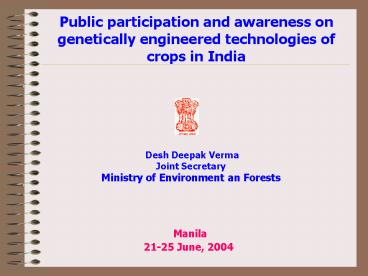Manila - PowerPoint PPT Presentation
1 / 23
Title:
Manila
Description:
Title: India: Biosafety Capacity Building Author: M.Hota Last modified by: Acer Valued Customers Created Date: 6/17/2004 10:16:34 AM Document presentation format – PowerPoint PPT presentation
Number of Views:95
Avg rating:3.0/5.0
Title: Manila
1
Public participation and awareness on genetically
engineered technologies of crops in India
Desh Deepak Verma Joint Secretary Ministry of
Environment an Forests
- Manila
- 21-25 June, 2004
2
- The Ministry of Environment and Forests is the
focal point for Convention on Biological
Diversity and all biodiversity related matters
including biosafety and - Ratified the Cartagena Protocol in January, 2003.
3
Biosafety Framework in IndiaGovernment
Commitment
- Government of India has committed to biosafety
issues by framing Rules for Manufacture, Use,
Import, Export and Storage of Hazardous
Microorganisms/ Genetically engineered organisms
or cells under the EPA (1986). - The 1989 Rules cover the entire spectrum of
activities relating to research, development and
use of Genetically Modified Organisms (GMOs) and
their products.
4
- Four principal facets of the biosafety regulatory
framework namely, institutional, legal,
environmental and public information are in
place. - In accordance with Article 8(g) of the
Convention, India is committed to establish or
maintain means to regulate, manage or control the
risks associated with the use and release of LMOs
resulting from biotechnology.
5
Current Regulatory Mechanism for GMOs Statutory
Bodies
- Institutional Biosafety Committee (IBSC)
- Review Committee on Genetic Manipulation (RCGM)
- Genetic Engineering Approval Committee (GEAC)
- State Biotechnology Coordination Committee (SBCC)
- District Level Committee (DLC)
6
BENEFITS OF GMOs IN AGRICULTURE
- Increased production to ensure food security
- Reduced need for clearing more land for farms
- Improved productivity of marginal lands
- Fall in the irrigation and agrochemical
requirements
Weed infested
Weed resistant
Golden rice with Vitamin A
Soyabean
7
POTENTIAL ENVIORNMENTAL AND RELATED PROBLEMS
- Development of insect resistance
- Effect on non target herbivore insects,
pollinators etc. - Gene flow to wild relatives leading to gene
contamination - Health hazard for human beings and cattle
- Possible transfer of antibiotic resistant genes
to other soil bacteria - Loss of local biodiversity
- Capture of market by GMO seed-Monopoly
8
ONGOING FIELD TRIALS IN THE WORLD
Red countries that are growing GM crops
Yellow countries that are field testing GM crops
9
MAJOR GM CROPS, THEIR TRAITS AND AREA (MHA)
Crop Trait Area in 2001
1. Soybean Herbicide-tolerant 33.3
2. Corn Insect resistant (Bt) 5.9
3. Canola Herbicide-tolerant 2.7
4. Cotton Herbicide-tolerant 2.5
5. Cotton Insect resistant (Bt)/ Herbicide-tolerant 2.4
6. Corn Herbicide-tolerant 2.1
7. Cotton Insect resistant (Bt) 1.9
8. Corn Insect resistant (Bt)/ Herbicide-tolerant 1.8
TOTAL 52.6
10
GM CROPS APPROVED IN INDIA
- Only one crop i.e. Bt cotton approved recently
with various conditions for a period of three
years by GEAC based upon recommendations of the
Monitoring and Evaluation Committee (MEC), ICAR
and biosafety evaluation.
Results of insect infestation on Bt (right) and
non-Bt (left) cotton bolls
11
(No Transcript)
12
Information sharing and data base management
- Networking with various institutes and agencies.
- Development of databases.
- Web management for information dissemination to
various stakeholders.
13
Involvement of stakeholders
- Societal acceptance is the key element for
successful implementation of various polices and
adaptation of technologies. - Introduction of public consultation mechanism.
- Public Awareness programs.
14
Institutions and Public participation
- Indian R D institutions have expertise for
conducting research in this area. However,they
need to be strengthened meet the challenges that
are emerging with the rapidly changing biosafety
scenario. - Information sharing protocols and additional data
capacity are needed to keep pace with the
expected increase in trans-boundary movement of
LMOs.
15
- Increasing public participation and awareness
building programmes for all stakeholder groups
play an important role. - Knowledge and methodologies on Biosafety will be
shared and transferred to the state agencies
through training and awareness programmes.
16
- Strengthening institutional capacity for
coordination and decision making across
ministries, specialized agencies and in state
government in areas related to biosafety and the
CP. - strengthen technical capacity to assess, manage
and monitor risks associated with biosafety
through the provision of training for core
capacity development in relevant stakeholder
ministries, specialized agencies and in state
governments.
17
Training cum awareness workshops in India
- To share the experience of the industry and
farmers with scientists, policy makers, state
governments and NGOs. - To sensitize and train state government officials
and other stakeholders for effective monitoring
of transgenic crops and review their performance.
18
- To demonstrate monitoring techniques to the
agriculture related officials in the states where
Bt cotton has been introduced. - To create a better understanding of the rules and
regulation related to biosafety of transgenic
crops and apprise about developments related to
transgenic crops in India.
19
The complexities of controversy
- Recent developments in the agricultural
biotechnology arena claim different degrees of
trust in regulatory institutions. - Risks are not resolved easily once they become
public controversies. - Public risk perception is influenced as much by
social relations and feelings of power.
20
- There is a need for developing integrated
information systems through networking of
institutions, databases, and establishment of a
biosafety-clearing house that would interalia
cover information on transboundary inventories of
GMOs.
21
- In addition to the scientific assessments,
socio-economic evaluation is also important for
acceptance of GMOs. - In this regard, creating awareness amongst
various stakeholders is extremely important.
22
Capacity Building in Biosafety in India
- Efforts are being made towards capacity building
within the country with the key thrust on
training and awareness. - Currently two such projects are underway
- FAO Regional Capacity Building Project on
Biosafety of GM Crops in Asia and - GEF-World Bank aided Capacity building project.
23
Thank You































